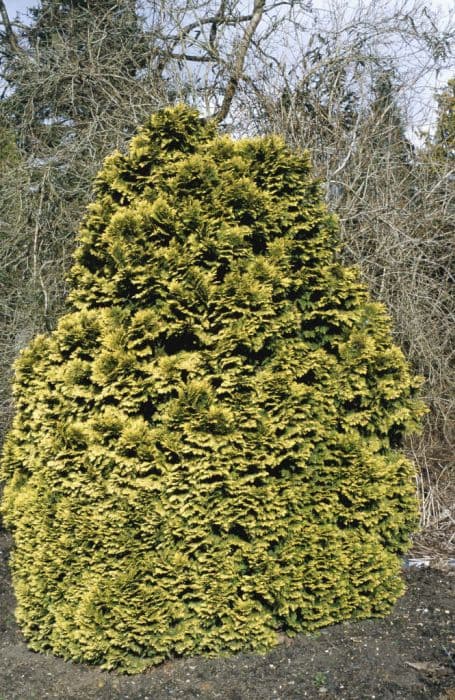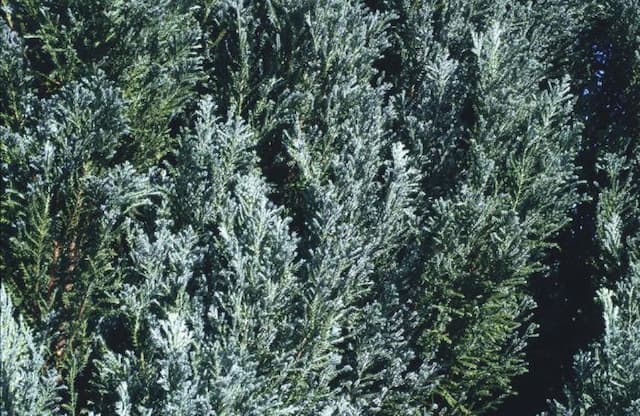Dwarf Japanese Garden Juniper Juniperus procumbens 'Nana'

ABOUT
The Juniperus procumbens 'Nana', commonly known as the Dwarf Japanese Garden Juniper, is a coniferous evergreen with a dense, ground-hugging habit. Its foliage consists of needle-like leaves that are arranged in compact clusters, presenting a lush and bushy appearance. The leaves exhibit a beautiful bluish-green hue that can add a tranquil tone to any landscape. This tough little plant is known for its woody, rope-like branches that twist and spread broadly across the ground. These strong branches bear the characteristic needles, which may give off a pleasant fragrance when crushed or brushed against. The Dwarf Japanese Garden Juniper can serve as a robust ground cover, turning rocky slopes into graceful sweeps of soft foliage. Throughout the year, the plant maintains its vibrant coloration, providing persistent visual interest regardless of the season. It may also produce small berry-like cones that start off as a greenish color and mature to a striking blue or bluish-black, often with a whitish, waxy coating. These berry-like structures add another layer of texture and interest, attracting various forms of wildlife and offering a striking contrast to the plant's foliage. Furthermore, the Dwarf Japanese Garden Juniper is appreciated for its contorted form, making it not only a staple in ground cover applications but also a popular choice for bonsai enthusiasts who admire and cultivate its natural twists and turns for artistic expression. This plant's ability to adapt to various growing conditions and its overall hardy nature make it a favored option for gardeners looking to add evergreen charm to their outdoor spaces.
About this plant
 Names
NamesSynonyms
Dwarf Japgarden Juniper, Japanese Garden Juniper, Nana Juniper, Dwarf Japanese Juniper.
Common names
Juniperus procumbens 'Nana'.
 Toxicity
ToxicityTo humans
The Japanese Garden Juniper is not commonly listed as a toxic plant to humans when touched or ingested in small amounts. However, consuming parts of the Japanese Garden Juniper, particularly the berries, in larger quantities can cause gastrointestinal irritation and upset, including symptoms like vomiting, diarrhea, and abdominal pain. The essential oils and other compounds found in junipers can also be toxic, so it's advised to handle the plant with care and not consume any part of it.
To pets
Japanese Garden Juniper is generally not considered highly toxic to pets. However, if a pet were to ingest a large amount of the plant material, especially the berries, it could potentially lead to gastrointestinal upset, evidenced by symptoms such as vomiting or diarrhea. It is always recommended to keep an eye on pets and prevent them from eating plants, as individual animals could have varied sensitivities or allergic reactions. To ensure the safety of pets, it is best to discourage them from ingesting any part of the Japanese Garden Juniper.
 Characteristics
CharacteristicsLife cycle
Perennials
Foliage type
Evergreen
Color of leaves
Green
Height
1 feet (30 cm)
Spread
6 feet (1.8 meters)
Plant type
Shrub
Hardiness zones
4-9
Native area
Japan
Benefits
 General Benefits
General Benefits- Landscape Design: Juniperus procumbens 'Nana' is widely used in landscape design due to its dense, compact growth habit and attractive green foliage, making it ideal for ground covers and rock gardens.
- Low Maintenance: This plant requires minimal care once established, making it a great option for gardeners seeking low-maintenance landscaping plants.
- Drought Tolerance: It is highly tolerant of drought conditions, which is beneficial for areas prone to water scarcity or for gardeners wanting to reduce their water usage.
- Erosion Control: The creeping habit of this juniper helps to prevent soil erosion, especially on slopes and in areas exposed to wind or water run-off.
- Year-Round Interest: With evergreen foliage, Juniperus procumbens 'Nana' provides visual interest throughout the year, regardless of the season.
- Wildlife Habitat: The dense foliage provides shelter and nesting opportunities for small birds and other wildlife.
- Soil Adaptability: This juniper can adapt to a wide range of soil types, though it prefers well-drained soils, making it versatile for different garden settings.
- Cold Hardy: It is resistant to cold temperatures, which allows it to thrive in cooler climates without special winter care.
- Pest and Disease Resistance: Juniperus procumbens 'Nana' has a natural resistance to many common pests and diseases, reducing the need for chemical treatments.
- Ornamental Cones: It produces ornamental berries/cones, which can add a decorative element to the garden and attract wildlife.
 Medical Properties
Medical PropertiesThis plant is not used for medical purposes.
 Air-purifying Qualities
Air-purifying QualitiesThis plant is not specifically known for air purifying qualities.
 Other Uses
Other Uses- Dwarf Japgarden junipernaise wasabi garnish - Its aromatic foliage can be finely chopped and used as a wasabi-like garnish for sushi and sashimi, providing a unique, coniferous flavor.
- Garden topiary - Dwarf Japgarden juniper's slow growth and compact form make it excellent for creating small topiary shapes for garden decoration.
- Photography backdrop - The plant's dense foliage and appealing texture are used as a natural backdrop for close-up photography of insects and other small wildlife.
- Aromatherapy sachets - Dried foliage can be placed in sachets to create a refreshing scent in drawers and closets.
- Culinary smoking - Wood from the Dwarf Japgarden juniper can be used to smoke meats and cheeses, imparting a distinctive, aromatic flavor.
- Natural insect repellent - Some people use the cut branches in outdoor areas to repel certain insects due to its strong scent.
- Bonsai teaching - Because the 'Nana' variety is commonly used for bonsai, it can be utilized in educational settings to teach the art of bonsai to beginners.
- Woodworking - The wood is sometimes harvested and used in small woodworking projects due to its fine grain and durability.
- Holiday decoration - Dwarf Japgarden juniper's evergreen appearance and conical shape make it suitable for use as miniature Christmas trees or in festive wreaths.
- Creative arts - The branches can be used for making wreaths or included in floral arrangements for texture and greenery.
Interesting Facts
 Feng Shui
Feng ShuiThe Dwarf Japgarden Juniper is not used in Feng Shui practice.
 Zodiac Sign Compitability
Zodiac Sign CompitabilityThe Dwarf Japgarden Juniper is not used in astrology practice.
 Plant Symbolism
Plant Symbolism- Protection: Juniper plants are commonly believed to offer protection, as their boughs were historically used to ward off evil spirits.
- Purity: Juniper is associated with purity and cleansing, often used in rituals to purify and cleanse the air or environment from negative influences.
- Healing: With a history of medicinal use, the juniper is a symbol of healing and is thought to have restorative properties.
- Longevity: As an evergreen, juniper represents endurance and longevity, symbolizing the ability to withstand the hardships of time.
 Water
WaterThe Japanese Garden Juniper needs to be watered regularly, but it's crucial to ensure proper drainage to prevent root rot. The soil should be allowed to dry out slightly between waterings. In the absence of rainfall, water your Japanese Garden Juniper every 7 to 10 days, providing about 1-2 gallons per plant for established plants, depending on your soil conditions and climate. Younger plants may require more frequent watering, such as once or twice a week, especially during hotter and drier periods. Monitoring the soil moisture is key, as overwatering can be as harmful as under-watering this species.
 Light
LightThe Japanese Garden Juniper thrives in full sun conditions and benefits from at least six hours of direct sunlight each day. It is best planted in a location that receives unfiltered sunlight for the majority of the day. Spots that offer bright, direct light will help ensure vigorous growth and maintain the dense, richly colored foliage that is characteristic of this plant.
 Temperature
TemperatureThe Japanese Garden Juniper is hardy and adapts to a range of temperatures, tolerating minimum temperatures down to -10 degrees Fahrenheit and maximum temperatures well above 100 degrees Fahrenheit. Ideally, it thrives in temperatures between 50 and 70 degrees Fahrenheit but can adjust to the seasonal variations typical of many temperate climates.
 Pruning
PruningPruning the Japanese Garden Juniper is important for maintaining its shape and promoting dense growth. It is best pruned in late winter or early spring before new growth starts. Light trimming can also be done throughout the growing season to remove any dead or damaged branches. It is typically not necessary to prune more than once or twice a year unless you are shaping the plant for bonsai or topiary purposes.
 Cleaning
CleaningAs needed
 Soil
SoilDwarf Japanese garden juniper prefers well-draining soil with a mixture of one-third peat moss, one-third gritty sand or perlite, and one-third topsoil, which should retain some moisture but also allow excess water to drain away. The soil pH ideal for this plant is slightly acidic to neutral, roughly between pH 5.5 and 7.0.
 Repotting
RepottingDwarf Japanese garden juniper should be repotted every two to three years to prevent root-bound conditions and to replenish its soil; younger plants may require more frequent repotting. It's best to do this in the spring or early fall.
 Humidity & Misting
Humidity & MistingDwarf Japanese garden juniper thrives in a wide range of humidity conditions, preferably average outdoor humidity levels. This plant does not require high humidity; it is well-suited to the naturally fluctuating humidity of outdoor environments.
 Suitable locations
Suitable locationsIndoor
Ensure bright light, cool temps, and air circulation for indoor Dwarf Japanese garden juniper.
Outdoor
Place in full sun, well-drained soil; protect from harsh winds for Dwarf Japanese garden juniper.
Hardiness zone
4-9 USDA
 Life cycle
Life cycleJuniperus procumbens 'Nana', commonly known as the Dwarf Japgarden Juniper, begins its lifecycle as a seed, which upon finding suitable conditions, germinates and develops into a seedling with a primary root and juvenile foliage. As the plant matures, it enters a vegetative stage, growing low to the ground with a spreading habit and developing its characteristic scale-like adult leaves. It may take several years for the juniper to reach sexual maturity, at which point it produces cones; the male cones release pollen while the female cones develop into berries called juniper berries. After pollination, the berries, which contain seeds, mature over one to three years before they are dispersed, often by birds, to start a new generation of junipers. Throughout its life, the Dwarf Japgarden Juniper is an evergreen, undergoing continuous growth and foliage replacement while maintaining its dense, green appearance. This slow-growing plant can live for many years, even centuries, under optimal conditions.
 Propogation
PropogationPropogation time
Summer to Fall
Juniperus procumbens 'Nana', commonly known as Dwarf Japgarden Juniper, is most commonly propagated through stem cuttings. This technique is generally performed during the latter part of summer when the wood is semi-hardened. Cuttings about 4 to 6 inches (10 to 15 centimeters) long are snipped from healthy, disease-free parent plants. The lower third of the cutting should be stripped of needles to expose the nodes where roots will form. Dipping the exposed end in a rooting hormone can improve the chances of successful rooting. The cutting is then planted in a well-draining soil mixture, ensuring high humidity and consistent moisture until roots develop, which usually takes several weeks to a few months. Once rooted, the young plants can be gradually acclimatized to their growing conditions before being transplanted to a permanent location.









